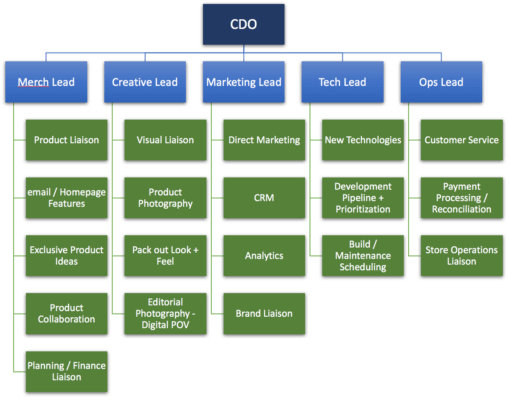Tumi’s chief digital officer shares how his org is built to go ‘beyond incrementality’
Contributors Erica Seidel and Nadine Dietz interview Charlie Cole, Chief Digital Officer of Tumi, to uncover the inner workings of his high-growth digital team that works in unison with marketing.
 Sibling rivalry is a problem in many organizations — especially when it comes to digital, brand and creative peers. So when we met Charlie Cole, Chief Digital Officer at Tumi, the international luxury travel and lifestyle brand, we were struck by how his organization is thriving with a model of “positive tension.”
Sibling rivalry is a problem in many organizations — especially when it comes to digital, brand and creative peers. So when we met Charlie Cole, Chief Digital Officer at Tumi, the international luxury travel and lifestyle brand, we were struck by how his organization is thriving with a model of “positive tension.”
In an interview with us, Cole shared how he’s organized his team and fostered a culture of honoring unique talents without compromising healthy debate. The results? Cross-functional alignment to help the brand grow “beyond incrementality” with more effective customer engagement, driving Tumi’s highest annual margin growth yet, Cole said.

Charlie Cole, chief digital officer of Tumi
Q: What are the customer dynamics at play at Tumi?
Let’s first remind ourselves that the customer doesn’t care about our org structure or the internal workarounds we’re doing to provide a great experience across all channels. The customer simply expects the best brand experience, regardless of whether they’re at an airport kiosk or on Amazon.com or on Tumi.com or at a Nordstrom store. So, it’s imperative that we put all our own needs aside and focus on working together to deliver on that expectation.
We are a travel brand, so by definition our customers interact with us in different countries and in different languages, expecting a consistent brand experience.
The beautiful thing about Tumi is once we win a customer, we have a customer for life. The challenging thing is that most of our customers don’t buy our products multiple times in a year, but multiple times over the course of many years. We have to carefully attribute across the entire customer lifecycle to ensure we continue our relationships in the most meaningful way at whatever point the customer engages.
Because of this dynamic, we’re becoming less promotional and more personal in our communications. As an example, we know our customers are swamped with emails, so we’ve cut 50 days out of the promotional calendar. Now when we do communicate, we provide a richer experience.
Q: Who do you report to? Who are your peers?
I report to the CEO. As Chief Digital Officer, I’m responsible for CRM (customer relationship management), analytics, attribution and direct response marketing. My peers include the leaders for creative, merchandising and brand.
This is unique. Within premium lifestyle brands, you often see the CEO and the creative lead running the show. But we’ve taken a radically different approach at Tumi to ensure we are firing on all cylinders. All four of us work together against the same goals, and we have a mutual respect for each other’s expertise, making us effective and efficient.
My job as the digital guy is to be the expert in my field, but given my marketing background, I do have opinions about what my brand lead is doing. The difference is that I defer to her expertise and simply weigh in where relevant, and vice versa. And if we somehow we can’t get on the same page, that’s when we include the CEO as the tie-breaker. But it’s our job to go to the CEO as seldom as possible.
Q: How do you draw the line between digital and marketing?
Ah, I have strong opinions about this! A lot of companies will say that digital is the most important investment, but then have the chief digital person report to the CMO. That sends the subconscious signal that digital is one level less than marketing. The reality is that digital and marketing are two very different and complementary domains.
[pullquote]”A lot of companies will say that digital is the most important investment, but then have the chief digital person report to the CMO. That sends the subconscious signal that digital is one level less than marketing.”[/pullquote]
It’s marketing/brand’s job to best understand and engage the customer from an emotional perspective. It’s digital’s job to continuously test and measure the impact of our engagement efforts.
I focus on how to provide the most immediate feedback on what’s working and what’s not so we can maximize our tactics. This calls for deep expertise in analytics, CRM, user experience, and marketing technology.
Similarly, there’s a big distinction between the creative team and the digital team. Let’s say you ask Vincent Van Gogh and Stephen Hawking to design a website. Vincent will give you a beautiful picture on the website, but it could get terrible conversion. Stephen will give you something with binary code and no emotional connection.
My job as the digital leader is not to draw the picture, but to test the guardrails set by higher levels of the organization. It’s up to my team to figure out whether we should use the same picture across multiple channels, what the most efficient way is to render that picture, who is responding, and whether that response meets our objectives.
[pullquote]“My job as the digital leader is not to draw the picture, but to test the guardrails.”
[Tweet this quote][/pullquote]
Q: How have you structured your digital team?
My team has approximately 20 people globally. I knew in order to deliver on the vision of being more personal and less promotional, I needed specialists who could take a digital-centric view.
When I first started at Tumi, I asked everyone on the digital team two questions: One, what are you doing? And two, what do you want to be doing? If someone said they were a generalist, I said, “No, that’s my job.”
I don’t have time for generalists; that’s the role of the C-suite. I need specialists — leads who drive their own budgets and know what they should be doing. With a bunch of generalists, that won’t work. Instead, I’m the mediator across the specialists when necessary.
The key functions reporting to me are merchandising, creative, marketing, technology, and operations:

Q: What results have you seen?
We used to be very focused on promotions, but promotions are like a drug. “We have to make more money!” is usually met with a) send another email or b) have a discount. But by differentiating Tumi through quality, while giving our customers personalized, relevant messages, we’ve been able to wean ourselves off that drug.
We now have the highest margin ever in digital for Tumi, and we’ve done this without sacrificing growth.
We are also able to achieve new heights due to our strong collaboration. For instance, we recently launched our most elaborate video-based campaign ever, called 19 Degree.
We’re seeing people spend two minutes+ on that page, which is just bananas! Our brand marketing head led that effort and absolutely crushed it — but what was cool is she had our team challenging her every step of the way, to hone things from the perspective of UI, UX, and digital analytics.
We never had to ask to be involved; we’re just two teams doing what we’re good at and creating positive tension!
Q: What’s your favorite interview question?
I’ll ask, “We’re launching a new product. Tell me all the questions you need to ask in order to launch it.” Some people freeze. I am OK with them taking the question home and responding later, after some thought. But it’s more impressive when someone can think on their feet in an interview.
I want to see that you can see a task through to fruition. I don’t need a cog in a machine; I need the machine!
Q: What do you recommend to someone starting a new marketing leadership role?
Realize that incrementality is your biggest enemy. It’s really hard for marketers to get beyond incrementality. With incremental gains, you don’t learn enough to succeed or fail. So don’t just celebrate the latest PR placement. Instead, ask your team, “How will you try something once per quarter that will be a huge failure?”
[pullquote]“Incrementality is your biggest enemy.”
[Tweet this quote][/pullquote]
Takeaways:
- Start with your long-term vision and know how you will differentiate from your competitors — this drives the way you organize, staff, execute, and measure results.
- Some organizations will proclaim how important digital is, but then organize in a way that sends signals that digital is less important. Be aware of this potential discrepancy.
- Everyone on a team can’t be painting on a white canvas as a generalist. You need specialists who can innovate within their area of expertise to drive the greatest results.
- Coach your team to embrace their expertise to lead where they should and acquiesce when appropriate. In Tumi’s case, this self-awareness drives cross-functional success.
- If you only focus on incremental gains, you’ll never get breakthrough innovation.
Contributing authors are invited to create content for MarTech and are chosen for their expertise and contribution to the search community. Our contributors work under the oversight of the editorial staff and contributions are checked for quality and relevance to our readers. MarTech is owned by Semrush. Contributor was not asked to make any direct or indirect mentions of Semrush. The opinions they express are their own.
Related stories